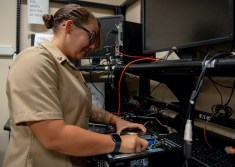Good, HP team up on mobility management on Navy’s next-gen network
The Navy announced Tuesday the addition of a new service that will keep its network secure for more than 800,000 users.
To support the growing number of smartphones and tablets connected to the Navy Marine Corps Intranet, or NMCI, the Navy is now using Good Technology’s Good For Enterprise to secure mission-critical data that passes through mobile devices.
Partnering with HP, which helps run the Navy’s Next Generation Enterprise Network, Good provides a suite of features that will offer security around agency data, give the Navy the option for an enterprise app store and remote containers if a device is lost or stolen.
“Over the past year, HP has worked with the NGEN Program Office to modernize NMCI in ways that improve the end user experience,” said Denby Starling, vice president for Navy and Marine Corps at HP. “As part of this ongoing transformation, we are proud to partner with Good Technology to bring Navy personnel the ability to connect anywhere, anytime with an expanded mobile device choice.”
Good CEO Christy Wyatt told FedScoop the partnership is an “entirely new scale of deployment within the Navy” that will allow users to adapt to the rapidly changing mobility ecosystem.
“Historically, entities have used a single device,” Wyatt said. “One of the benefits of deploying something like Good is while the device landscape looks one way today, it could look very different next year or the year after that, so regardless of what device they choose, they have a consistent risk management and security framework in Good.”
Good has been aggressive within the Defense Department over the past year, and its offerings are already in use in the Army and Air Force. Last August, the company was issued its sixth Secure Technical Implementation Guide, or STIG, from the Defense Information Systems Agency for use on Apple’s iOS 7 platform.
On top of the DISA approval, the company’s mobile enterprise offerings are the only ones to achieve Common Criteria EAL4+ certification for iOS and Android.
Wyatt said the security has been baked into Good’s products since the company’s beginning, a decade ago.
“It’s really up to the end customer to decide where they want to set the dial,” whether that company is a bank, a hospital or the Navy, Wyatt said.
By shoring up security, the product allows enterprises to figure out how they can be more efficient and innovative with their mobile devices.
“Once they’ve rolled that out and see the scalability and reliability and security, the ideas for what’s next come from inside the organization, and they come fast and furious,” Wyatt said. “If you think about it, the folks creating applications and thinking about how to make end users’ lives easier, they have always had a lot of great ideas about how to use these devices, but if only they could have permission to put these applications and services in the hands of the users.”






